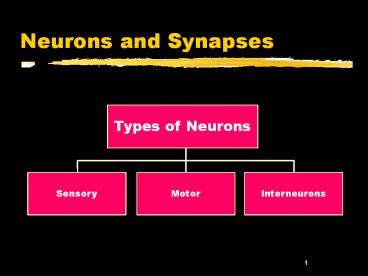Neurons%20and%20Synapses - PowerPoint PPT Presentation
Title:
Neurons%20and%20Synapses
Description:
Neurons and Synapses Types of Neurons Sensory Motor Interneurons Sensory Neurons INPUT From sensory organs to the brain and spinal cord. Motor Neurons OUTPUT From the ... – PowerPoint PPT presentation
Number of Views:265
Avg rating:3.0/5.0
Title: Neurons%20and%20Synapses
1
Neurons and Synapses
Types of Neurons
Sensory
Motor
Interneurons
2
Sensory Neurons
- INPUT From sensory organs to the brain and
spinal cord.
Brain
Sensory Neuron
Drawing shows a somatosensory neuron Vision,
hearing, taste and smell nerves are cranial, not
spinal
Spinal Cord
3
Motor Neurons
- OUTPUT From the brain and spinal cord To the
muscles and glands.
4
Interneurons
- Interneurons carry information between other
neurons only found in the brain and spinal cord.
5
Structures of a neuron
6
The cell body
- Contains the cells Nucleus
- Round, centrally located structure
- Contains DNA
- Controls protein manufacturing
- Directs metabolism
- No role in neural signaling
7
Dendrites
- Information collectors
- Receive inputs from neighboring neurons
- Inputs may number in thousands
- If enough inputs the cells AXON may generate an
output
8
Dendritic Growth
- Mature neurons generally cant divide
- But new dendrites can grow
- Provides room for more connections to other
neurons - New connections are basis for learning
9
Axon
- The cells output structure
- One axon per cell, 2 distinct parts
- tubelike structure branches at end that connect
to dendrites of other cells
10
Myelin sheath
- White fatty casing on axon
- Acts as an electrical insulator
- Not present on all cells
- When present increases the speed of neural
signals down the axon.
11
How neurons communicate
- Neurons communicate by means of an electrical
signal called the Action Potential - Action Potentials are based on movements of ions
between the outside and inside of the cell - When an Action Potential occurs a molecular
message is sent to neighboring neurons
12
Ion concentrations
13
The Cell Membrane is Semi-Permeable
14
Resting Potential
- At rest the inside of the cell is at -70
microvolts - With inputs to dendrites inside becomes more
positive - if resting potential rises above threshold an
action potential starts to travel from cell body
down the axon - Figure shows resting axon being approached by an
AP
15
Depolarization ahead of AP
- AP opens cell membrane to allow sodium (NA) in
- inside of cell rapidly becomes more positive than
outside - this depolarization travels down the axon as
leading edge of the AP
16
Repolarization follows
- After depolarization potassium (K) moves out
restoring the inside to a negative voltage - This is called repolarization
- The rapid depolarization and repolarization
produce a pattern called a spike discharge
17
Finally, Hyperpolarization
- Repolarization leads to a voltage below the
resting potential, called hyperpolarization - Now neuron cannot produce a new action potential
- This is the refractory period
18
Neuron to Neuron
- Axons branch out and end near dendrites of
neighboring cells - Axon terminals are the tips of the axons
branches - A gap separates the axon terminals from dendrites
- Gap is the Synapse
19
Synapse
- axon terminals contain small storage sacs called
synaptic vesicles
- vesicles contain neurotransmitter molecules
20
Neurotransmitter Release
- Action Potential causes vesicle to open
- Neurotransmitter released into synapse
- Locks onto receptor molecule in postsynaptic
membrane
21
Locks and Keys
- Neurotransmitter molecules have specific shapes
- Receptor molecules have binding sites
- When NT binds to receptor, ions enter
positive ions (NA ) depolarize the neuron
negative ions (CL-) hyperpolarize
22
Some Drugs work on receptors
- Some drugs are shaped like neurotransmitters
- Antagonists fit the receptor but poorly and
block the NT - e.g. beta blockers
- Agonists fit receptor well and act like the NT
- e.g. nicotine.
23
Summary
- 3 types of neurons
- The cell membrane
- Ion movements
- Action potentials
- Synapse
- Neurotransmitters
- Receptors and ions
- Agonists and antagonists































